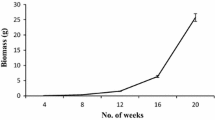Abstract
An efficient system to produce saikosaponins (saikosaponin-a and -d) in Bupleurum falcatum adventitious root fragments combined with signal transducers was developed. The roots are heterogeneous in terms of size and shape and sometimes form aggregates during cultivation. When the roots were cut to lengths of about 5 mm using a scalpel and cultivated, the root fragments did not form the aggregates, and root growth and saikosaponin production were not inhibited. After screening various signal transducers, it was clear that methyl jasmonate (MeJA) markedly promoted saikosaponin production. By comparing the effect of MeJA and related substances on saikosaponin production, we conclude that both the pentenyl and carboxylmethyl group of MeJA play an important role in the promotion of saikosaponin production. Addition of both 100 µM MeJA and 20 mM CaCl2 to the medium stimulated the content of saikosaponin in the root, with levels reaching 31.7 mg/g-dry root for 15 days of cultivation. A large amount of root fragments were prepared using a blender and cultivated (23 g-dry root/l) with 400 µM MeJA and 20 mM CaCl2, resulting in a high concentration of saikosaponins (747.3 mg/l).
Similar content being viewed by others
Author information
Authors and Affiliations
Additional information
Received revision: 24 July 2001
Electronic Publication
Rights and permissions
About this article
Cite this article
Aoyagi, .H., Kobayashi, .Y., Yamada, .K. et al. Efficient production of saikosaponins in Bupleurum falcatum root fragments combined with signal transducers. Appl Microbiol Biotechnol 57, 482–488 (2001). https://doi.org/10.1007/s002530100819
Received:
Accepted:
Issue Date:
DOI: https://doi.org/10.1007/s002530100819




